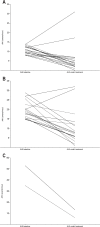Usage of positional therapy in adults with obstructive sleep apnea
- PMID: 25406271
- PMCID: PMC4298770
- DOI: 10.5664/jcsm.4458
Usage of positional therapy in adults with obstructive sleep apnea
Abstract
Study objectives: Many positional therapy (PT) strategies are available for treating positional obstructive sleep apnea (OSA). PT is primarily supplied to selected patients as a secondary treatment option when other therapies have failed. To our knowledge this is the largest study to date to assess effectiveness and long-term compliance of PT (both commercial waistband and self-made constructions, mimicking the tennis ball technique) as primary treatment in patients with different positional OSA severities.
Methods: PT was used by 53 patients, of which 40 patients underwent a follow-up polygraphic evaluation under treatment after a median time interval of 12 weeks. Patients were routinely contacted regarding their clinical status and treatment compliance.
Results: PT was successful in 27 out of 40 patients (68%). Overall AHI reduced significantly from a median (interquartile range [IQR]) AHI of 14.5 (10.7-19.6) to 5.9 (3.1-8.5), p < 0.001. The commercial waistband and self-made constructions were equally effective (median (IQR) reduction in overall AHI (Δ9.6 (5.5-11.9) and Δ6.8 (3.2-11.3) respectively), p = 0.22). Short-term compliance was good as most patients used PT more than 7 hours/night (mean 7.2 ± SD 1.4) and more than 6 days/ week (mean 6.5 ± SD 1.3). However, after mean 13±5 months, 26 patients (65%) reported they no longer used PT, especially patients with moderate positional OSA (89%).
Conclusions: On the short-term, PT using the tennis ball technique, is an easy method to treat most patients with positional OSA, showing significant reductions in AHI. Unfortunately, long-term compliance is low and close follow-up of patients on PT with regard to their compliance is necessary.
Keywords: breathing disorder; compliance; effectiveness; obstructive sleep apnea; positional therapy; sleep-related.
© 2015 American Academy of Sleep Medicine.
Figures




References
-
- Banno K, Kryger MH. Sleep apnea: clinical investigations in humans. Sleep Med. 2007;8:400–26. - PubMed
-
- Malhotra A, White DP. Obstructive sleep apnoea. Lancet. 2002;360:237–45. - PubMed
-
- Oksenberg A, Silverberg DS. The effect of body posture on sleep-related breathing disorders: facts and therapeutic implications. Sleep Med Rev. 1998;2:139–62. - PubMed
Publication types
MeSH terms
LinkOut - more resources
Full Text Sources
Other Literature Sources
Medical

